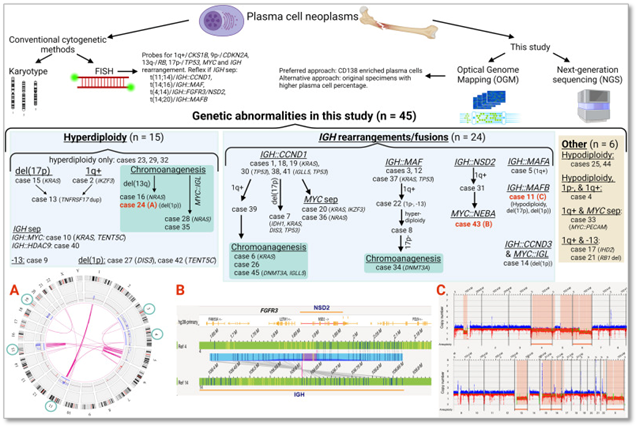Blog
Unveiling the Genetic Landscape of Multiple Myeloma: A Leap Forward with Optical Genome Mapping
Key Takeaways
- Comprehensive Genetic Insights: The study, covered in this blog, showcases the enhanced capability of optical genome mapping (OGM) combined with next-generation sequencing (NGS) to provide a more comprehensive analysis of genetic abnormalities in multiple myeloma than traditional methods like FISH and karyotyping.
- High Concordance and Sensitivity: Findings reveal a high concordance between the results of FISH and OGM, with OGM also displaying superior sensitivity and specificity in detecting genetic abnormalities, crucial for precise risk stratification and disease management.
- Innovative Workflow Integration: The research advocates for a novel, integrated workflow that includes both OGM and NGS, aimed at improving the detection and characterization of structural and numerical genetic variations.
- Potential Impact to Healthcare: By providing a more detailed genetic landscape, the proposed OGM-NGS integrated approach holds promise for improving healthcare in the future, as research in this field evolves, since genomics information is expected to lead to more personalized management and improved outcomes for multiple myeloma patients.
- Future Implications: This study sets a precedent for future clinical research, emphasizing the need to adopt advanced genomic tools like OGM and NGS to unravel the complex genetic underpinnings of multiple myeloma.

Understanding the Complex Genetics of Multiple Myeloma
Multiple myeloma (MM) remains a formidable challenge in the realm of hematologic malignancies, primarily due to its complex genetic landscape. It’s a type of cancer that forms in plasma cells, which are crucial components of the immune system. With a notable incidence rate, the disease continues to be the subject of intense research and clinical interest. Multiple myeloma is marked by a broad spectrum of genetic variations, including structural variants (SVs) like translocations involving the IGH and MYC genes, copy number variants (CNVs) such as gains and losses of specific chromosomal regions, and numerous mutations in pivotal cancer pathways.
Despite advancements in technologies, many biomarkers integral to understanding and managing multiple myeloma remain elusive. Current standard procedures like karyotyping (KT) and fluorescence in-situ hybridization (FISH) offer valuable insights yet are limited by their resolution and the breadth of genomic anomalies they can detect.
A Pioneering Study by Prestigious Institutions
A groundbreaking study from two renowned institutions, The Johns Hopkins Hospital and The University of Texas MD Anderson Cancer Center, introduces an integrated approach combining optical genome mapping (OGM) with next-generation sequencing (NGS) to dissect the genetic intricacies of multiple myeloma.
Detailed Analysis and Key Findings
The study, authored by Ying S. Zou, Melanie Klausner, and their colleagues, analyzed 45 samples, employing a multifaceted assessment that included traditional methods like KT and FISH, alongside the innovative OGM and NGS techniques. The study was performed on CD138+ plasma cells.
Exclusive Findings by OGM:
- Complex Genomic Rearrangements: OGM detected complex nested inversions within chromosome 8q involving the MYC gene (Case #16) and an IGH::MYC fusion in case #10, which were only equivocally identified by FISH. These findings are crucial as they involve key cancer proliferation and progression genes.
- Additional Copy Number Variants and Chromoanagenesis: OGM revealed extensive hyperdiploidy and hypodiploidy not assessed by FISH, enhancing the understanding of the disease’s genomic instability. Notably, chromoanagenesis was detected in 8 samples, indicating massive genomic rearrangements that have significant implications for clinical research.
- Gene-Specific Insights: Gains of chromosome 1q were detected in several samples, a known high-risk factor in multiple myeloma. Moreover, OGM identified gains of BCMA/TNFRSF17 on 16p13.13 in multiple samples.
Study Implications for Laboratories
The publication notably advocates for a standardized workflow utilizing OGM in conjunction with NGS. This recommended approach aims to maximize the detection of genomic abnormalities, aiding in more accurate risk stratification and disease management. The ability of OGM to identify known and novel genetic aberrations presents a promising avenue to advance our understanding of multiple myeloma pathogenesis and positively impact healthcare.

Forward-Looking Perspectives
This study underscores the robustness of combining OGM with NGS and sets a new precedent in the genetic characterization of multiple myeloma. It provides a compelling case for the adoption of these advanced methodologies in routine assessments of samples, offering a beacon of hope for future possibilities of enhancing patient outcomes through more informed and personalized treatment plans.
As we continue to navigate the complexities of multiple myeloma, the insights from this pivotal research, detailed in the recent publication in the Blood Cancer Journal, will undoubtedly influence future studies and clinical research, driving forward the integration of cutting-edge genomic tools in the fight against this challenging disease.
Reference: Zou, Y.S., Klausner, M., et al. (2024). A comprehensive approach to evaluate genetic abnormalities in multiple myeloma using optical genome mapping. Blood Cancer Journal.



